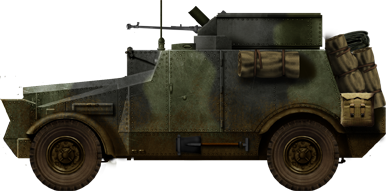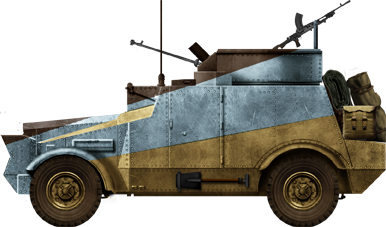Development of the Morris CS9
Morris Motors was one of the most influential and prolific car-maker in Great Britain, and a logical choice for building armored cars, even without an official order from the General Staff. However, in this case, there was already an official need, expressed in 1935, to replace WW1-era models and, in 1936, Morris Commercial Cars, a subsidiary of Morris Motors, tried to develop a prototype based on the C9 4x2 15-cwt truck chassis. This vehicle was tested the same year and, in 1937, after a few modifications, accepted for service and followed by an order for 99 to be delivered next year. Army classification was LAC (Light Armoured Car).Design
This vehicle was built on the large 15-inch Morris Commercial C9, a rear-wheel drive commercial vehicle chassis, which had a payload capacity up to 750 kg. The compartmentalization was straightforward, with a front driver cab and a rear fighting compartment topped by a fully traversing armored basket, rather than a fully enclosed turret. In this open top turret was installed a 0.55 in (13.97 mm) antitank gun Boys Anti-tank Rifle, a 0.3 in (7.62 mm) Bren light machine gun or a 12.7 mm (0.5 in) Vickers HMG (the scaled up version of the standard cal. 0.303), and a central smoke grenade launcher tube. The driver sat on the right, and had a forward three-faceted cabin, with lateral openings which could be occulted by a sliding steel cap. The front hood was protected by a rather complicatedly faceted riveted armored body, and there was a slight side slope, but no step or rear storage. A shovel, mace and pickaxe were fastened in a transverse position in front of the turret deflector. There were standard and blackout lights and a No. 19 radio set. The Morris 6-cylinder petrol gave 96 hp (72 kW) or a power/weight of 21.3 hp/tonne, served by a standard 4f/1r gearbox. The suspension was 4 x 2, with a rear fixed axle -double tires- providing motricity and a front steering axle.The Morris CS9 in action
In April 1939, the LAC entered service with the Royal Tank Corps. Thirty-eight of the CS9 were given in to the 12th Royal Lancers, replacing the model 1928 4x6 Lanchesters. These were part of the BEF, participating in the Battle of France and Flanders, where all were destroyed or abandoned near Dunkirk. The other 30 served with the 11th Hussars, and were shipped to participate in the North African campaign, together with WW1-era Rolls-Royce LACs. It was found that, when fitted with desert tires, the vehicle had good performance on soft sand. However, its armor and armament were insufficient. The vehicle was retired halfway through the North African campaign. These vehicles participated in the desert war against the Italian 10th Army and used until 1943, some being captured and reused by German and Italian troops.Morris CS9 specifications |
|
| Dimensions | 15.6 x 6.9 x 7 ft (4.77 x 2.05 x 2.13 m) |
| Total weight, battle ready | 4.5 tons (9000 lbs) |
| Crew | 4 (driver, gunner, commander, radio operator) |
| Propulsion | Morris 6-cylinder petrol 96 hp (72 kW), 21.3 hp/ton |
| Suspension | 2x4 leaf springs |
| Speed (road) | 45 mph (73 km/h) |
| Range | 240 miles (380 km) |
| Armament | Main: 0.55 (13.97 mm) in Boys Antitank rifle Secondary: 0.303 in (7.7 mm) Bren LMG or 0.5 in (12.7 mm) Vickers HMG |
| Armor | 7 mm overall (0.3 in) |
| Total production | 99 |

Morris CS9 with 12th Lancers, British Expeditionary Force (BEF), Franco-Belgian frontier, May 1940.

CS9 of the 11th Hussars, Libya, 1942.

CS9 of C Squadron, 12th Royal Lancers (Prince of Wales\' Own) at Villiers-St-Simon with the BEF in 1940

CS9 on the Libyan frontier, 11th Hussars, 26 July 1940.

WW2 Tanks




























WW2 tanks posters

All Tiger tanks liveries.

Panther liveries and variants

WW2 Armour - All tanks











Tanks aces and single tanks series

Find more there

Museums, Movies, Books & Games
The Tanks and Armor in pop culture
Tanks and armored vehicles in general are only really grasped when seen first person: The mass, the scale, it's all there. Explore also the way tanks were covered in the movie industry, in books and in video games.Movies:
Best tanks movie on warhistoryonline.com
On imdb.com
On bestsimilar.com/
miltours.com
liveabout.com/
watchmojo.com
Video Games:
pcgamesn.com
historyhit.com
levvvel.com
vg247.com/best-tank-games
mmobomb.com/
alienwarearena.com

